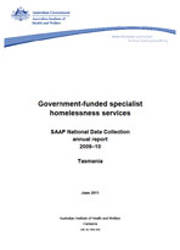Summary
This publication is one of eight state and territory supplements that accompany the 2009–10 national annual report on the use of government-funded specialist homelessness services (AIHW 2011a). Information to aid readers in interpreting the data is presented in the national report and appendixes (AIHW 2011i).
In line with the national picture, in Tasmania:
- the majority of clients were female
- the average age of clients was in their early thirties
- Aboriginal and Torres Strait Islander people were over-represented relative to their population size
- clients commonly sought support because of issues in their interpersonal relationships— such as the breakdown of a relationship with a family member, spouse or partner—or because of accommodation related issues
- immediately following support, most clients were living in a house or flat, they were not employed, and their main source of income was a government pension or benefit.
Some other points of interest in Tasmania were:
- the rate of use of specialist homelessness services was higher than the national average
- there was a higher proportion of male clients than in other jurisdictions
- seeking support because of interpersonal relationship issues was relatively low compared with nationally
- seeking support because of accommodation related issues was relatively high compared with nationally
- the length of support was longer than the national average
- the length of accommodation was shorter than the national average
- Tasmania was the only jurisdiction in which both the periods of support and the number of people supported have decreased over recent years. There has also been a small overall decrease in the rate of use of specialist homelessness services
- going against the national trend, the proportion of support periods in Tasmania that include a period of specialist homelessness accommodation has increased over recent years.



